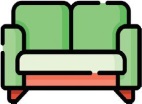SAFE AT HOME : SIMPLE TIPS FOR GENERAL HOME SAFETY cont.

LEG LIFTER STRAP
(May be helpful to have a therapist provide instructions)
- It can be ordered online. It is used to help someone bring their leg in and out of the bed, if this is a struggle.
- Some examples are post-stroke, postsurgery, swollen/weak leg. Typically, it runs $9-$11.

HOSPITAL BED
(May be helpful to have a therapist provide instructions)
A hospital bed is a great option for anyone who just returned from the hospital and is unable to perform steps to access their second-floor bedroom. It can be adjustable, and can help with pain, swelling, pulmonary, cardiac, and other issues.
- It reduces the chance of injury for the caregiver.
- It helps elevate legs to reduce swelling.
- It helps with pressure relief.
- You typically need a letter from a primary care physician and can sometimes be difficult to get covered by insurance.
- It can be a safer option if your loved one is at risk for falling out of bed.
- Only a few diagnoses qualify a person to get it covered, so ask a medical professional or therapist.
- There are several types: fully electric, partial electric, bariatric, and manual

TRANSFER BOARD
(A therapist should provide training)
- Also called sliding board, it is typically made of wood or plastic
- It serves as a bridge that allows a per
son to move from one surface to another, ie. from a bed to wheelchair, or a bed to a commode.
- It allows a person to move from one surface to another without using their legs.
- It can be very helpful for a caregiver to reduce fall risk when getting a client from point A to point B.
- Check with a medical supply company to see if it is covered by insurance.

PRESSURE RELIEF
(For Wheelchair or Hospital Bed)
- A cushion or pad can be placed on the wheelchair seat or over the mattress on a hospital bed.
- Typically, it is used if the loved one has a wound, or is at risk for skin breakdown, and is unable to walk or spends most of the time in bed or in a wheelchair.
- Remember the golden rule is to change positions every two hours to displace pressure on bony prominences and reduce the risk of developing a pressure sore.
- While in bed, it may be necessary to have your family member elevate his/her heels to reduce pressure; as this is a typical place where skin breakdown can occur.

(It is helpful to have a therapist work with your loved one to problem solve.) If your loved one spends a lot of time on the couch, and struggles getting up and down due to the couch being low or soft:
- Place a pillow underneath the cushion to elevate the height of the sitting surface.
- Make sure you provide proper sequencing instructions when getting up (see below).

CHAIRS WITH ARM RESTS, ELECTRIC SEAT LIFT, POWER LIFT RECLINER
Seating is an important topic for seniors. There are several options, and caregivers may find this overwhelming. Again, speaking to a professional, typically a therapist, can provide insight into the right equipment.
- Arm Rests: as mentioned the in previous article, it is best to have a senior sit in chairs that have arm rests, to provide ease of transfer in and out of the chair.
HOW TO PERFORM A TRANSFER
A transfer is defined as moving from one place to another. Here are a few simple instructions for your elderly loved one to use when getting up from any surface safely.
- Scoot forward
- Put your weight forward, “nose over toes” You may need to use a little momentum, by rocking back and forth “one, two, three”
- Put hands on couch/chair
- PUSH UP Only pull up if there is something very secure, like a well installed grab bar
- When getting up from a chair to a walker, push-up, using the arms of the chair, and then reach for the walker, do not use the handles of the walker to pull yourself up. NEVER put your hands on the walker to pull up.
